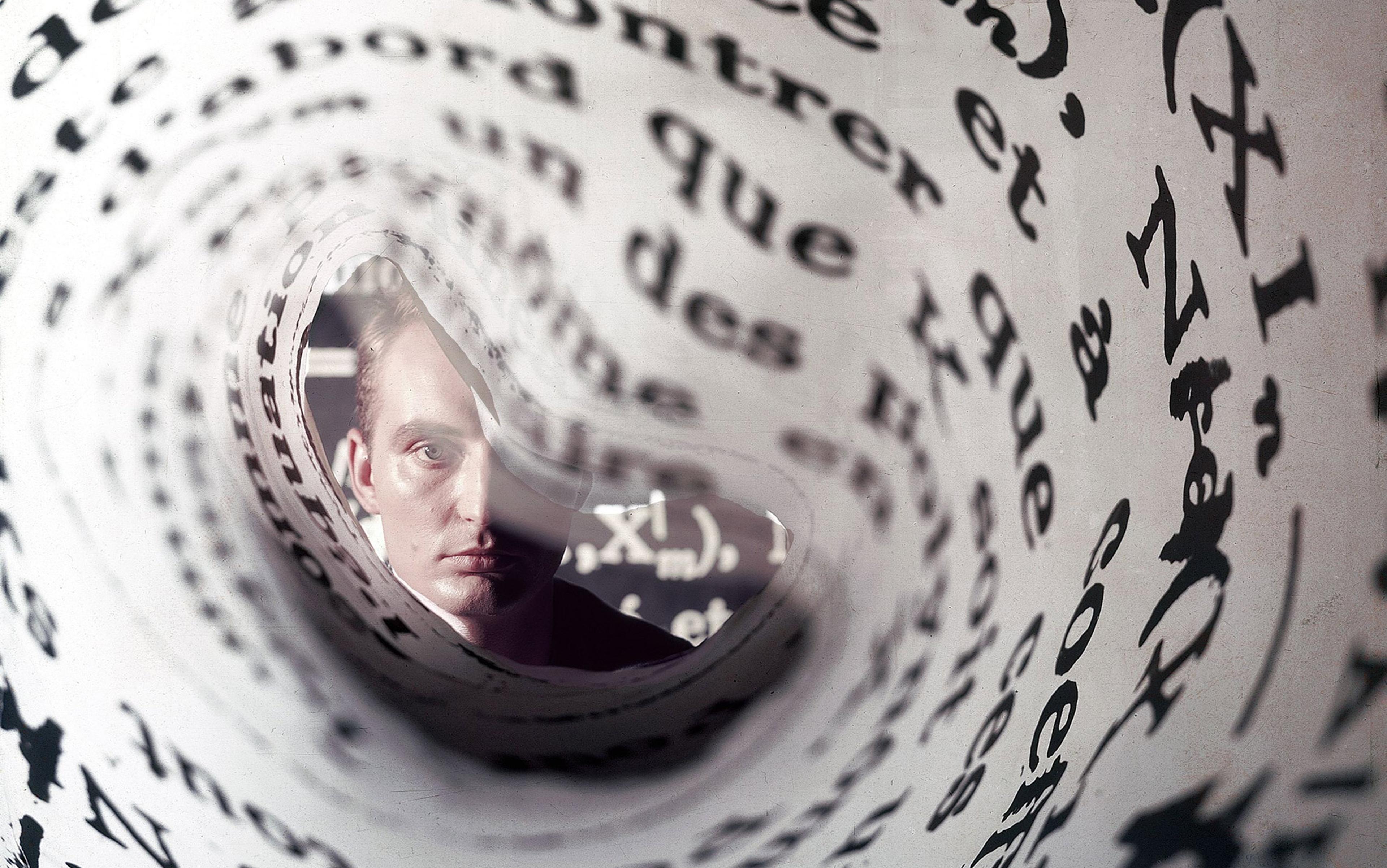‘These foundations [of mathematics] are, moreover, a perpetual source of reflection and discovery for the masters of the science. Even in number system you will find material for long reflection. Remember that Leibniz did not disdain to occupy himself with it.’ – Paul Valéry, letter to Pierre Honnorat, 1942
There are almost too many examples of the power and pervasiveness of mathematical ideas. For instance, this essay was written on a computer. The software of the computer, its mind and spirit, if you will, is a compilation of code that is based on the ideas of Claude Shannon, the father of information theory, and his article ‘A Mathematical Theory of Communication’ (1948). But perhaps this is both too obvious and too slight an example. The personal computer is hardly an essential part of human existence, even if most of us have structured our lives around it today. Let’s take something more basic and widespread, something most of us probably already apprehend, even if only dimly – like the idea of regression to the mean.
As the Oxford English Dictionary explains, regression to the mean is ‘the tendency for the values of any distributed variable to move towards the mean over repeated independent trials’. In other words, the more trials, the less random or mistaken the measure. For instance, say you’re in a race at school. You do surprisingly well and beat most of your classmates. All things being equal, the next time around, you’re actually not likely to do as well, relative to the other runners. Obviously, one’s actual rank depends on skill and talent – if you did well the first time, you probably are pretty fast – but each result also depends on luck as well as a host of other circumstances. Therefore, in order to mitigate against any selection effect, one has to run the experiment multiple times. In order to be able to see just where you actually place or rank, you have to be able to know the shape or form of the distribution of outcomes. The notion of regression to the mean informs how we think about a wide range of things, from the design of clinical trials, to gambling, to, well, the prosaic pep-talks we give ourselves after coming up short by saying: ‘OK, next time will be better.’ Actually, it probably will be.
The Victorian polymath (and eugenicist) Sir Francis Galton first discovered and formulated the idea of regression to the mean in his studies of heredity. The ‘regression toward mediocrity’, in Galton’s memorable phrase, grew out of his studies of why genius seemed to run through families (think of the Bachs), but then also how and why it dissipated over time. Genius and talent themselves being impossible to measure, Galton studied other more quantifiable phenomena, for instance, the height differences between parents and children, and the spatial distribution of falling objects. He devised a contraption called the Quincunx, and found that when uniformly dropped objects encountered small deviations (think of a pinball machine with lots of stoppers), they nevertheless distributed themselves at the bottom along a normal distribution – what we generally call a bell curve. The bell curve, of course, is just one example of the various forms used to plot the relationship among independent and dependent variables. Galton’s conceptual innovation, his idea of regression to the mean, made certain features of the world newly visible. By doing so, he helped us count and describe other things we can’t see, or test, but that shape our lives.
The modern separation among scholars between intellectual history and the history of mathematics is untenable as mathematics might be the ultimate intellectual endeavour. In the words of the 19th-century German mathematician Carl Friedrich Gauss: ‘mathematics is the queen of the sciences’; like literacy, widespread numeracy is one of the defining features of modernity. In fact, one of the great shifts of modernity has been how mathematicians changed their view of mathematics, transforming the focus of their work from the study of the natural world to the study of ideas and concepts. Perhaps more than any other subject, mathematics is about the study of ideas. Yet, when people invoke the history of ideas, you are unlikely to hear about Dedekind’s cut (that is, the technique by which the real numbers are rigorously defined from the rational numbers), or L E J Brouwer’s rejection of Aristotle’s ‘law of excluded middle’, which states that any proposition is either true or that its negation is (put technically: for all propositions p, either p or not p). Nor are you likely to hear about the contested history of these ideas. Generally, when they talk about ideas, intellectual historians today mean political thought, cultural analysis, and maybe a sprinkling of economic and religious concepts, too.
Nor has this divide been one-sided. As the historian John Tresch recently noted: ‘For most historians of science trained in the past 30 years, doing history of science has meant avoiding the history of ideas.’ Even though most historians of science would surely consider the history of mathematics part of their field, in fact the subject is more often conspicuous by its absence than its presence. However, the larger problem among historians of science is that, while the consolidation of the field over the previous century has been an institutional and economic success, it has segregated the field. Today, it primarily takes place within separate departments or committees, with separate training. This reinforces, in practice and effect, a division between the study of science and the study of society – something its own literature repeatedly criticises.
‘Mathematics, like any literature, is created by human beings for their own amusement’
One of the many damaging results of this intellectual division is that most of us – that is, those of us who are not mathematicians, physicists or engineers – adopt a view of mathematics that is primarily the product of our encounter with it in grade school. For most people, unfortunately, mathematics is a set of confusing, repetitive, formalistic and abstract techniques. Yet this is exactly the opposite of how mathematicians see their own work. Rather, what attracts them, in the words of The Mathematics Lover’s Companion (2017) by the graph theorist Ed Scheinerman, are ‘joyful, beautiful’ theorems and proofs, which they arrive at through the sweat of intellectual play. Akin to the best poems, they contain truths about the world perfectly expressed.
Perhaps the most impassioned remonstration against our bifurcated view of mathematics is the pamphlet A Mathematician’s Lament (2009) by the American private-school teacher Paul Lockhart. Written in 2002 and circulated for years among mathematicians and educators, Lockhart’s essay ruthlessly criticised the simplistic nature of most mandatory mathematics education. Mathematics, Lockhart wrote, is almost always taught in a way to obscure the actual insights and reasoning, the grandeur and insight, the excitement and frustration, that drive mathematicians. ‘At no time are students let in on the secret that mathematics, like any literature, is created by human beings for their own amusement,’ Lockhart writes, attempting to humanise the subject.
Continuing with his literature analogy, Lockhart emphasises that: ‘A piece of mathematics is like a poem, and we can ask if it satisfies our aesthetic criteria: is this argument sound? Does it make sense? Is it simple and elegant? Does it get me closer to the heart of the matter?’ And like most pieces of art, truly appreciating it is not a rote exercise: ‘works of mathematics are subject to critical appraisal; that one can have and develop mathematical taste’. By teaching mathematics as a series of techniques, the appeal and nature of mathematics is masked: ‘Of course there’s no criticism going on in school – there’s no art being done to criticise!’ The notable English mathematician G H Hardy also compared mathematics to poetry in his own work A Mathematician’s Apology (1940): ‘A mathematician, like a painter or a poet, is a maker of patterns. If his patterns are more permanent than theirs, it is because they are made with ideas.’
What then might we all learn from better integrating the two? What might be gained if, to quote Egon Spengler in the film Ghostbusters (1984), ‘we cross the streams’ of the history of mathematics and the history of ideas?
We should not understand the history of ideas as one besotted by speculations about politics. With that, hopefully, we can gain a wider sense of the diverse ideas and visions that, deep down (for better and for worse), motivate and inform any of our endeavours. Intellectual history today is dominated by elite political ideas. There are many factors that have contributed to the shortchanging of the history of mathematics and its ideas. High among them is how narrowly political the work of leading intellectual historians has been.
The British scholar Quentin Skinner and the French philosopher Michel Foucault, for example, are arguably the most influential intellectual historians of the past 50 years. Superficially, they are unlike each other in almost every way, from their prose style, to their subjects. Yet both portray intellectual history mostly in terms of political languages and expressions of power. The discourses and mentalities of individuals, for both of them, describe much of the social and political world, and account for when and why change happens. But one of the most important reasons for the rise of the modern state is the increasing possible reach of politicians and bureaucrats, changes powerfully facilitated by improvements in mathematics and technology, and that are absent in both of their accounts.
Recognising the role of mathematics in the history of how we think would actually make us more sophisticated in our political judgment. Those wishing to lend certainty and authority to their ideologies use mathematics, but they also abuse it. As the epitome of formal knowledge and the premier example of abstract reason, the spectre of mathematics has haunted European thought for centuries. From theologians to politicians and economists, many have naively – even manipulatively – adopted mathematical methods to develop, and too often implement, overly simplistic theories of the world. Despite the repeated problems with this approach, the impulse has been seminal, formative and comparatively neglected.
The discipline of economics offers a recent example, but this is also true for areas as widely separate as architecture and philosophy, as the political scientist and anthropologist James C Scott shows in his book Seeing Like a State: How Certain Schemes to Improve the Human Condition Have Failed (1999). The allure of formal schemes has turned people’s attention to the results of mathematics, rather than to the creative ways that mathematicians work and think. Commenting on the aftermath of the late 19th- and early 20th-century controversy over the foundations of his subject, the influential mathematician John von Neumann wrote in the essay The Mathematician (1947) that ‘[T]he very concept of “absolute” mathematical rigour is not immutable. The variability of the concept of rigour shows that something else besides mathematical abstraction must enter into the makeup of mathematics.’ While the reason that mathematics is authoritative is due of its supposed rigour and certainty, what we mean by rigour has changed throughout history, based on novel ideas and realisations. How mathematics works rests on no absolute timeless standard, despite what many assume today, given its precision and efficacy.
Taking mathematics seriously might lead thinking back to questions of aesthetics and beauty
In some ways, mathematics is the hardest, and most realistic, art. The German philosopher Martin Heidegger, for instance, offers an example of an influential thinker who misrepresented mathematics as a kind of thinking divorced from the natural world. In the essay ‘Modern Science, Metaphysics, and Mathematics’ (1962), he writes: ‘In the mathematical project develops an obligation to principles demanded by the mathematical itself.’ In Heidegger’s view, the embrace of mathematics and technology brings a kind of repetitious, routinised, alienating world in its wake. The paradox, however, is that a desire to bypass repetitious exercises is precisely one of the things that motivates mathematicians. Elementary proofs are nothing if not ways to think about something in all applicable cases so that repetitive testing on each possibility is not necessary. Nothing could be more elegant. Describing technology and mathematical modes of thought as mechanistic and alienating mistakes the result for the process.
Finally, taking mathematical ideas seriously might lead to discovering that technical ideas are as important as political or religious ones. Taking mathematics seriously might also, counter to stereotypes, lead thinking away from current preoccupations with culture and power, and back to questions of aesthetics and beauty. Aesthetics and beauty are ever-present concerns in art and in mathematics, though seemingly small matters to historians and humanists today, preoccupied as they are with power.
Take, for example, the case of the Weils: Simone Weil was an important literary and political writer, regarded as one of the more insightful religious philosophers and social critics of the first half of the 20th century; her brother André, a mathematician, made important contributions to a variety of areas of mathematics, but is much less widely known, unless one is a mathematician. There are many colourful anecdotes about André Weil’s life – he escaped war-torn Europe and lived all around the world – but perhaps most importantly, and amusingly, he was a founding member the Bourbaki group. This was a loose association of mostly French mathematicians in the first half of the 20th century who tried to put mathematics on a new and self-contained basis (a recurring goal in the history of mathematics and, more generally, the history of thought). One of the main ways they tried to achieve this goal was by collectively writing textbooks under the name of a fictitious character, one Nicolas Bourbaki. Bourbaki doesn’t exist, but he published not a few books, and came up with some of the terms and symbols modern mathematicians use, such as Ø to represent the empty set. André Weil led the first meeting of the Bourbaki group.
And Weil is just the beginning. There’s Shannon and his insights into information theory, along with his teacher, the prodigy Norbert Wiener, who coined the term ‘cybernetics’ (and wrote a scintillating two-volume autobiography). There’s the debates between Brouwer and David Hilbert about the basis of mathematics. And there’s the extraordinary career of Emmy Noether, who made contributions across many fields of mathematics and physics, and helped to apply abstract algebra to topology (which deals with the preservation of spatial properties during transformations of shape and size, and is one of the main ways topology is done today). In other words, it would mean beginning to be as interested in the creators of our technological civilisation as history has been in those who lament it.
The history of ideas can, should and, historically, has often been precisely about the limitations of politics and the rewards of other ideas; it need not primarily be the study of thinkers who, more often than not, never even directly held power. The ideas that most deeply shape us, and our societies, are just as often not part of the history of political thought, but come from many other areas. This is not an argument for a neo-Platonic worshipful examination of ideas, or for a move away from considerations of politics. It is rather a call to recognise the ways in which humans actually encounter ideas, and the unique vitality of mathematical ideas in the world.






